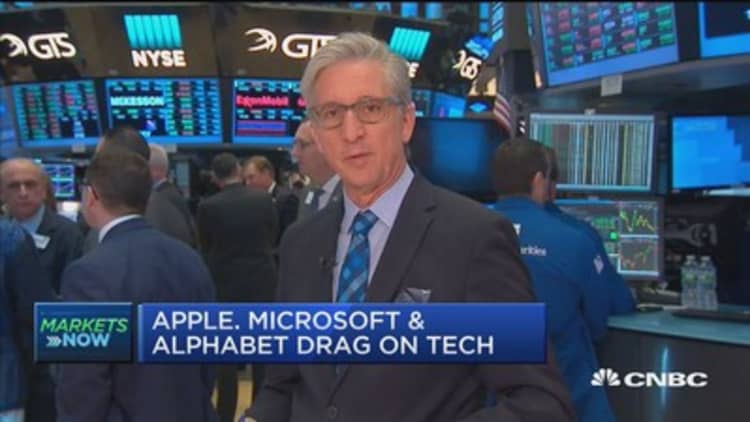
For the second day in a row, value stocks (banks, energy) are outperforming growth stocks (technology). Has the time finally arrived for value stocks?
Growth versus value is one of the oldest investment styles known. Value-buying stocks that are underpriced, according to some fundamental metric, such as price-to-book ratio, gained fame under Ben Graham and David Dodd, whose 1934 text "Security Analysis" is generally viewed as the bible of value investing, even though they never explicitly used the phrase "value investing."
One thing is clear: buying growth stocks—those that are growing earnings at an above-average rate — has been a sound strategy this year. The iShares S&P Growth ETF (IVW) is up 12.5 percent year to date, while the iShares S&P Value (IVE) is up only 4.1 percent.
Why is there such outperformance this year for growth? As a rule, growth stocks this year are technology, consumer discretionary, and health care.
As a rule, value stocks this year are financials, energy, and consumer staples.
It shouldn't surprise you that the reason growth has outperformed value is because of the huge outperformance of big-cap tech stocks. Here are the top holdings in the S&P Growth Index, by their weight in the index.
S&P Growth: top holdings
Apple: 7 percent
Microsoft: 4.8 percent
Amazon: 3.4 percent
Facebook: 3.1 percent
Google: 2.6 percent
These are the so-called "FANG" stocks (with Microsoft added) that everyone has been talking about this year.
By contrast, the Value index's biggest names are energy and financials, which have all underperformed this year:
S&P Value: top holdings
(by weighting)
Exxon Mobil: 3.6 percent
Berkshire Hathaway: 3.4 percent
JPMorgan: 3.3 percent
AT&T: 2.5 percent
Wells Fargo: 2.5 percent
For the past two days, we have seen a rotation out of tech outperformers and into energy and bank underperformers. This is a healthy sign: rather than just selling off, investors are using these over-owned technology names as a source of funds to buy underperforming energy and bank names.
Will that continue? Opinions are divided. Keith Lerner, chief market strategist at SunTrust Advisory Services, splits the difference by telling clients, "We are not advising a style tilt at this point" but notes the obvious: "On a short-term basis, value's underperformance is moving to an extreme and due for a reprieve."
The good news is that the action in the past couple days is a good reminder that nothing goes in a straight line and the momentum guys can just as quickly abandon growth names, and have done so many times in the past. And growth does not have a monopoly on price appreciation: there are long periods when value does outperform. Lerner notes that while growth has outperformed value this year, growth underperformed value by 9 percent in 2016.
"Thus, over the entire period from 2016 until now, growth's outperformance is less extreme at less than 4%," Lerner notes.
One final note: a common complaint about growth vs. value investing is that you get a lot of "bleed," that is, because the parameters of what constitutes value and growth are a bit fuzzy, you can (and do) get stocks that have characteristics of both, so they are usually included in both indices. For example, General Electric, Procter & Gamble, and Johnson & Johnson are in both the Growth and Value indices.
If this bothers you—that you can get the same stocks in two different investment styles that seem, well, opposite—you're not alone. There have been numerous attempts to create "pure" investment styles.
Sticking with ETFs, one example is Guggenheim's S&P 500 Pure Growth (RPG) and S&P 500 Pure Value (RPV) ETFs. Guggenheim splits the S&P into three groups: a growth basket that weights stocks on traditional growth fundamentals (sales and earnings growth, price momentum), a value basket that weights value stocks on traditional value fundamentals (price/book ratio, sales/price ratio, and earnings/price ratio), and a "blend basket" of stocks that have both growth & value attributes. It throws out the "blend basket" and creates funds that they believe how "purer" growth and value characteristics.
The results? It sounds like a good idea, but at least this year there's not a huge difference between the performances of the S&P 500 Growth and Value and the "Pure" S&P 500 Growth and Value Indices:
Growth and Value ETFs
(YTD)
iShares S&P Growth (IVW) up 12.5 percent
Guggenheim S&P 500 Pure Growth (RPG) up 12.8 percent
iShares S&P Value (IVE) up 4.1 percent
Guggenheim S&P 500 Pure Value (RPV) up 3.8 percent


